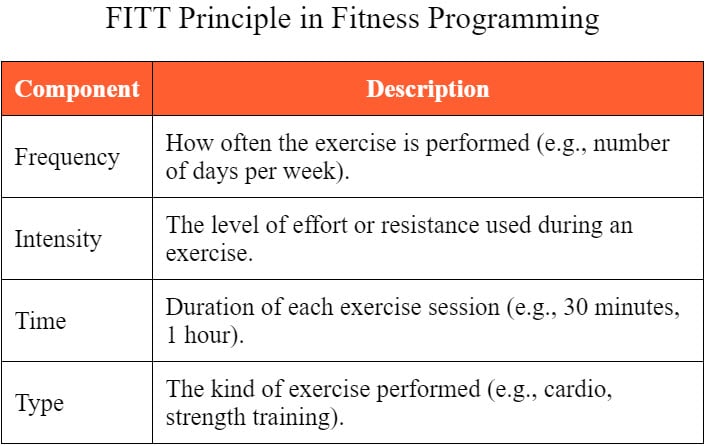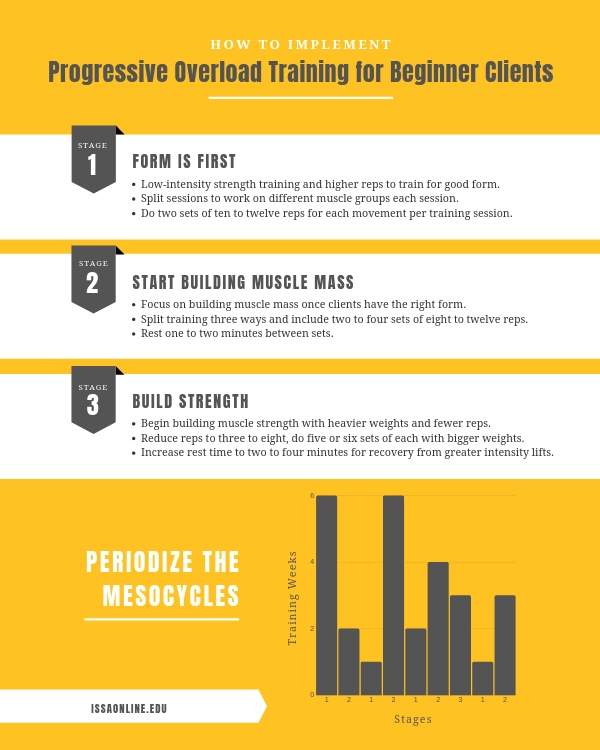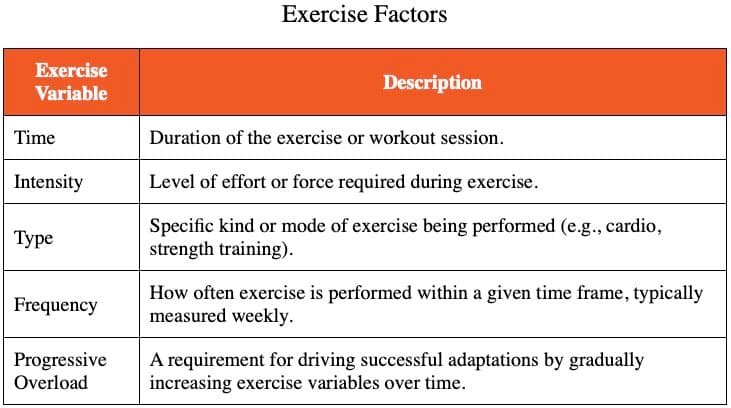How Does The Overload Principle Apply To A Successful Fitness Program? It involves progressively increasing the intensity, duration, or frequency of exercise to continually challenge the body and promote adaptations.
This principle applies to all fitness goals, whether it’s building muscle, improving endurance, or losing weight. To achieve the desired results, individuals must push their bodies beyond their comfort zone and provide a stimulus for growth. This means gradually increasing the weight lifted, running longer distances, or adding more sets and reps to a workout routine.
By doing so, the body responds by getting stronger, fitter, and healthier. Applying the overload principle requires careful planning and monitoring to prevent injury and burnout. It’s important to gradually increase the workload and allow for adequate rest and recovery time. With consistent effort and a focus on progression, the overload principle can lead to significant improvements in fitness and overall health.

Credit: traineracademy.org
The Overload Principle Revealed
The Overload Principle is a fundamental concept in fitness that serves as the cornerstone for achieving progress and growth in any training regimen. Understanding and implementing this principle is crucial for individuals aiming to maximize their fitness results and achieve their goals effectively.
Essence Of Progressive Overloading
Progressive overloading involves gradually increasing the demands placed on the body during exercise. This can be achieved through various means, such as increasing the weight lifted, performing more repetitions, or extending the duration of the workout. By consistently challenging the body in this manner, it adapts and becomes stronger, ultimately leading to improved fitness levels and performance.
Historical Roots In Strength Training
The concept of progressive overload has deep roots in the history of strength training. It dates back to ancient Greece, where Milo of Croton, a renowned wrestler, reportedly carried a calf daily as it grew into a full-sized bull. This anecdote exemplifies the essence of progressive overloading – as the calf grew, so did Milo’s strength, illustrating the principle’s timeless effectiveness.
Biological Underpinnings
In a successful fitness program, the overload principle is crucial. This principle involves gradually increasing the intensity of exercise to stimulate muscle growth and strength. By pushing the body beyond its current limits, the overload principle triggers biological adaptations that lead to improved fitness and performance.
The overload principle is a fundamental concept in exercise science, and it is essential to understand how it applies to a successful fitness program. The biological underpinnings of the overload principle involve the muscle adaptation process and the stress and recovery cycle.
Muscle Adaptation Process
The muscle adaptation process is the physiological response of the muscle to the stress of exercise. When the muscle is subjected to a load greater than what it is used to, it experiences microtrauma. This microtrauma initiates a series of biochemical processes that lead to muscle growth and repair. The muscle adapts to the stress, becoming stronger and more resilient.
Stress And Recovery Cycle
The stress and recovery cycle is the balance between the stress of exercise and the recovery needed to allow the muscle to adapt and grow. The stress of exercise is necessary to initiate the muscle adaptation process, but recovery is equally important. Without adequate recovery, the muscle cannot adapt and grow.
The stress and recovery cycle must be carefully managed to prevent overtraining and injury. Understanding the biological underpinnings of the overload principle is critical to the success of a fitness program. By applying the principles of muscle adaptation and stress and recovery, you can design a program that is challenging, yet safe and effective. Remember to listen to your body and adjust your program as needed to achieve your fitness goals.
Crafting Your Fitness Regimen
When it comes to crafting a successful fitness regimen, understanding the overload principle is crucial. This principle states that in order to make progress and see results, you must gradually increase the demands placed on your body. By challenging your muscles, cardiovascular system, and overall fitness level, you can stimulate growth and improvement.
Setting Benchmarks
Setting benchmarks is an essential step in creating an effective fitness program. These benchmarks serve as a starting point for your fitness journey and help you track your progress along the way. Begin by assessing your current fitness level and establishing specific goals you want to achieve. Whether it’s increasing your strength, improving your endurance, or losing weight, having clear benchmarks allows you to measure your success.
One effective way to set benchmarks is by conducting fitness assessments. These assessments can include body measurements, strength tests, and cardiovascular endurance tests. By understanding your baseline fitness level, you can tailor your program to your individual needs and gradually increase the intensity over time.
Incremental Progression Strategies
Once you have set your benchmarks, it’s time to implement incremental progression strategies into your fitness program. These strategies involve gradually increasing the difficulty or intensity of your workouts to continuously challenge your body and prevent plateauing.
One way to incorporate incremental progression is by increasing the weight or resistance in your strength training exercises. Start with lighter weights and gradually add more as your muscles adapt and become stronger. This progressive overload stimulates muscle growth and ensures continued progress.
In cardiovascular exercises, you can apply the overload principle by gradually increasing the duration or intensity of your workouts. For example, if you’re jogging, you can gradually increase the distance or speed over time. This gradual progression keeps your cardiovascular system challenged and helps improve your endurance.
It’s important to note that incremental progression should be done in a safe and sustainable manner. Pushing yourself too hard or too quickly can lead to injuries or burnout. Listen to your body and make adjustments accordingly.
By applying the overload principle and incorporating incremental progression strategies into your fitness program, you can maximize your results and achieve your fitness goals. Remember to always consult with a healthcare professional or fitness expert before starting any new exercise regimen.

Credit: www.crossfitinvictus.com
Key Exercises For Maximizing Gains
To maximize gains in a fitness program, incorporating the overload principle is crucial. Key exercises such as squats, deadlifts, and bench presses are essential for applying this principle, as they require progressively increasing resistance to stimulate muscle growth and strength.
These exercises promote continuous improvement and prevent plateauing in fitness progress.
Compound Movements
Compound movements are key exercises that engage multiple muscle groups and joints simultaneously, making them highly effective for maximizing gains in a fitness program. These exercises involve complex movements and require coordination, stability, and strength. By incorporating compound movements into your routine, you can target multiple muscle groups at once, leading to improved overall strength and muscle development.
One of the most popular compound movements is the squat. Squats target the muscles in your lower body, including your quadriceps, hamstrings, and glutes. They also engage your core muscles for stability. Performing squats with proper form and gradually increasing the weight can help you build lower body strength and improve overall athletic performance.
Another effective compound movement is the deadlift. Deadlifts primarily target your posterior chain, including your hamstrings, glutes, and lower back. They also engage your upper back, core, and grip strength. Deadlifts are known for their ability to build overall strength and power, making them a staple exercise in many fitness programs.
Additionally, the bench press is a compound movement that targets your chest, shoulders, and triceps. It also engages your core and stabilizer muscles. By incorporating the bench press into your routine, you can improve upper body strength and muscle development.
Isolation Techniques
While compound movements are crucial for maximizing gains, isolation techniques are equally important to target specific muscles and improve muscle definition. Isolation exercises focus on a single muscle group and allow you to isolate and target it with precision. One effective isolation technique is the bicep curl. Bicep curls specifically target your biceps and help build arm strength and definition.
By performing bicep curls with proper form and gradually increasing the weight, you can effectively target and strengthen your biceps. Another effective isolation exercise is the tricep pushdown. This exercise targets the triceps, the muscles on the back of your upper arms. By performing tricep pushdowns, you can isolate and strengthen these muscles, leading to improved arm strength and definition.
In addition to bicep curls and tricep pushdowns, there are various isolation exercises for different muscle groups, such as leg extensions for targeting the quadriceps and lateral raises for targeting the shoulders. By incorporating isolation techniques into your fitness program, you can ensure that each muscle group is adequately targeted and developed. In conclusion, incorporating compound movements and isolation techniques into your fitness program is crucial for maximizing gains.
Compound movements engage multiple muscle groups and joints, leading to overall strength and muscle development. Isolation techniques, on the other hand, allow you to target specific muscles and improve muscle definition. By combining both approaches, you can create a well-rounded and effective fitness program that helps you achieve your goals.
Monitoring Progress And Avoiding Plateaus
Monitoring Progress and Avoiding Plateaus are crucial components of a successful fitness program. To ensure ongoing progress, it’s important to implement strategies that prevent the body from reaching a plateau and continuously challenge the muscles for growth and improvement.
Tracking Workouts Effectively
One of the key aspects of overcoming plateaus and monitoring progress in a fitness program is to track workouts effectively. By keeping a detailed record of each workout session, individuals can identify patterns, strengths, and weaknesses. This data allows for adjustments to be made to the workout routine, ensuring continual progress and preventing plateaus.
Strategies To Surpass Sticking Points
When progress begins to stall, implementing specific strategies can help individuals surpass sticking points and break through plateaus. Incorporating techniques such as periodization, varying intensity, and modifying exercise selection can prevent the body from adapting to the routine, leading to sustained progress and continual improvement.
Nutrition And Overload
Nutrition plays a vital role in supporting the overload principle within a successful fitness program. By providing the body with essential nutrients, individuals can optimize their performance, enhance recovery, and achieve their fitness goals more effectively. Fueling for Recovery, Macronutrient Considerations are crucial aspects of nutrition that directly impact the application of the overload principle.
Fueling For Recovery
After intense workouts, the body requires adequate nutrition to repair and replenish. This process of recovery is essential for progress and is supported by consuming a well-balanced post-workout meal or snack. This should include a combination of protein, carbohydrates, and healthy fats to promote muscle repair, glycogen replenishment, and overall recovery.
Macronutrient Considerations
When applying the overload principle, it is important to consider the intake of macronutrients – protein, carbohydrates, and fats. Each plays a specific role in supporting physical activity, recovery, and adaptation. Protein is crucial for muscle repair and growth, while carbohydrates provide energy for workouts and aid in glycogen replenishment. Healthy fats support overall health and hormone regulation, contributing to the body’s ability to handle increased training loads.
Risks Of Overtraining
Overtraining poses risks to a successful fitness program. By understanding how the overload principle applies, individuals can avoid the negative consequences of pushing their bodies too far. Regular rest and recovery periods are crucial for preventing injuries and optimizing performance.
Recognizing Symptoms
Physical and mental signs can indicate overtraining.
Importance Of Rest And Deload Phases
Rest and deload phases prevent overtraining and aid recovery.
Real-world Success Stories
The Overload Principle is a key factor in achieving real-world success in a fitness program. By consistently challenging the body with increasing levels of intensity, individuals can optimize their results and reach their fitness goals.
Athletes Who Thrived
Elite athletes exemplify the effectiveness of the Overload Principle.
They consistently push their limits, progressively increasing intensity.
Transformations Through Overload
Ordinary individuals achieve remarkable transformations using Overload.
Gradually challenging themselves leads to sustainable results.
Tailoring Overload To Individual Needs
When designing a successful fitness program, the overload principle plays a crucial role. It involves gradually increasing the challenge to ensure continuous progress. Tailoring overload to individual needs is essential for optimal results.
Future Of Fitness: Overload Innovations
Emerging Research
New studies shaping the future of fitness programs.
Discoveries enhancing the effectiveness of overload principle.
Technology Integration In Training
Modern tech revolutionizing workout routines.
Wearable devices tracking progress and optimizing performance.
Conclusion
To sum up, understanding and applying the overload principle is crucial for a successful fitness program. By gradually increasing intensity, duration, or frequency, individuals can continually challenge their bodies and make progress. This principle helps optimize workouts, leading to improved strength, endurance, and overall fitness results.

Credit: www.issaonline.com
Frequently Asked Questions about How Does The Overload Principle Apply To A Successful Fitness Program?
Faq 1: What Is The Overload Principle In Fitness?
- The Overload Principle in fitness refers to the concept of gradually increasing the intensity, duration, or frequency of your workouts to continually challenge your body and stimulate further progress.
Faq 2: How Does The Overload Principle Contribute To A Successful Fitness Program?
- By applying the Overload Principle, you push your body beyond its comfort zone, forcing it to adapt and become stronger, fitter, and more resilient over time. This leads to better results and a successful fitness program.
Faq 3: What Are The Benefits Of Incorporating The Overload Principle Into My Workouts?
- Incorporating the Overload Principle helps improve muscular strength, endurance, and cardiovascular fitness. It also promotes weight loss, increases bone density, and enhances overall physical performance.
Faq 4: Can The Overload Principle Be Applied To Any Type Of Exercise?
- Yes, the Overload Principle can be applied to various types of exercises, including strength training, cardio workouts, and flexibility exercises. It can be tailored to suit individual fitness goals and preferences.
Faq 5: How Often Should I Apply The Overload Principle In My Fitness Routine?
- To ensure progress and avoid plateauing, it is recommended to gradually increase the intensity or challenge of your workouts every 4-6 weeks. This allows your body to adapt and continue making gains in strength and fitness.

















